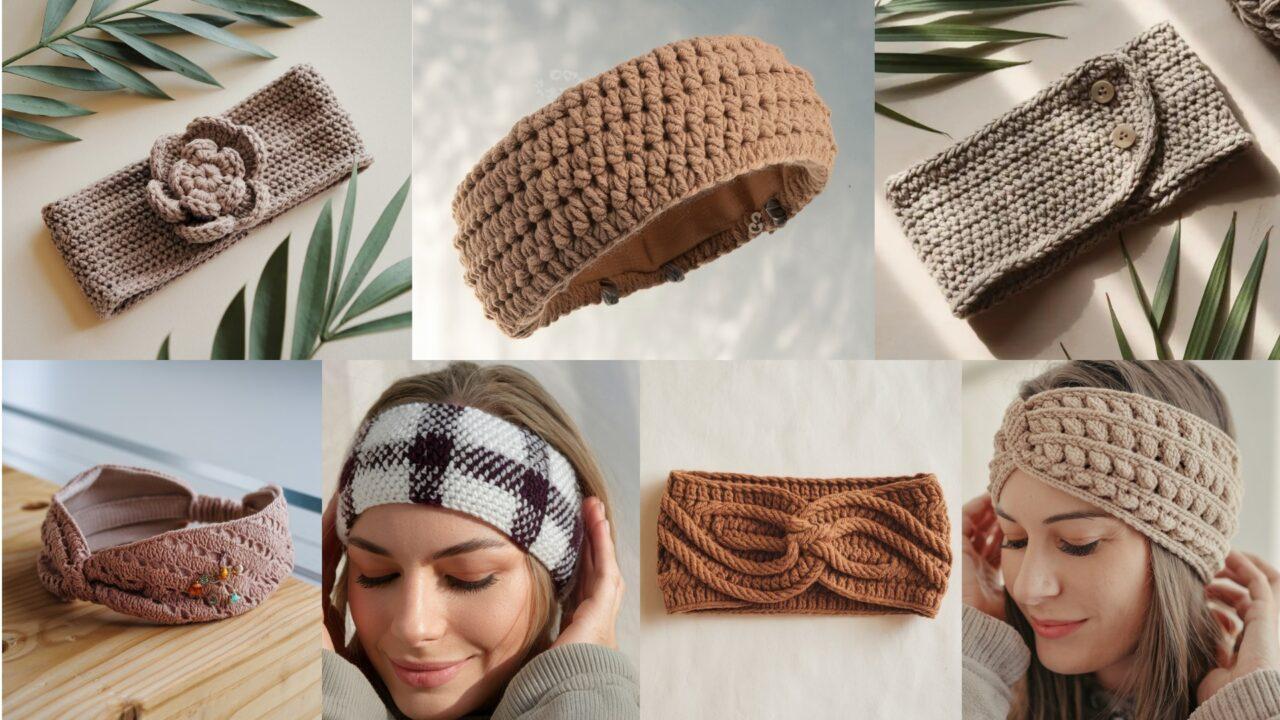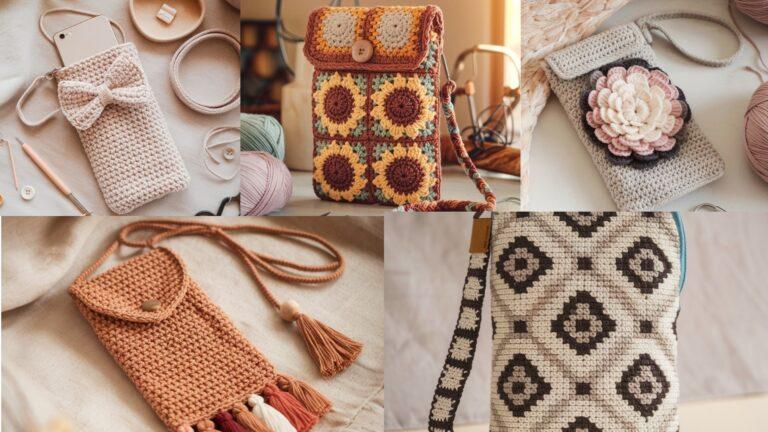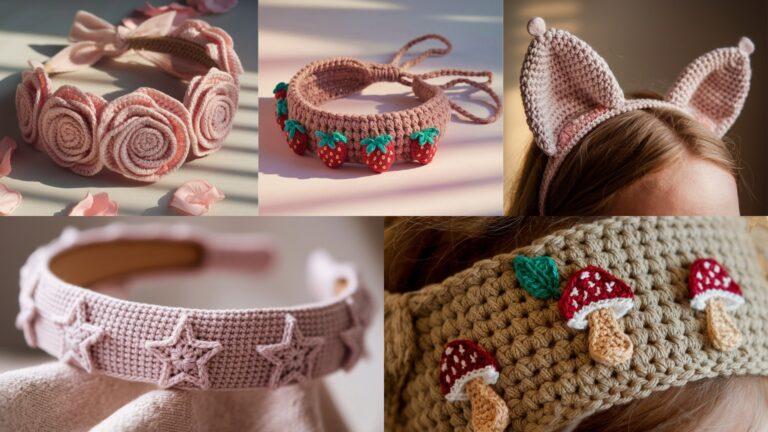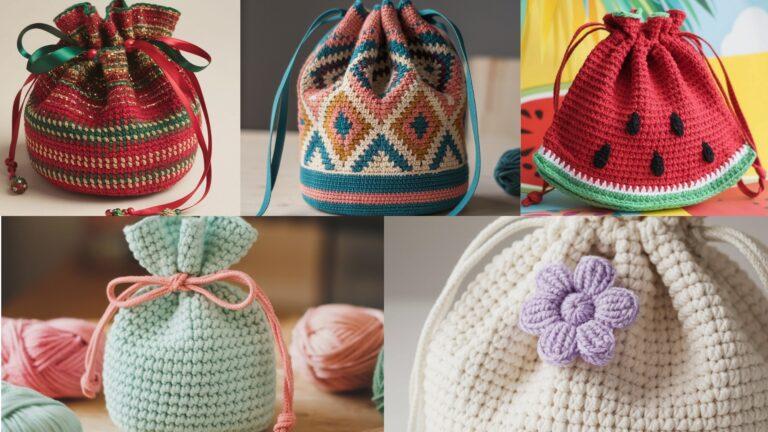Cold mornings, brisk walks, and sweater weather call for a cozy ear warmer (aka headband) — a tiny project that’s fast to make, wonderfully giftable, and endlessly customizable. Below are seven fully detailed ear warmer patterns: from a rustic twisted cable look to Tunisian honeycomb, from floral accents to adjustable straps and plaid colorwork. Each pattern includes materials, gauge, finished size, a stitch glossary, a step-by-step construction guide, finishing tips, and simple variations so you can make each design your own.
Before you jump into patterns, read the common notes and sizing advice so your ear warmer fits perfectly.
Quick notes (read first)
- Abbreviations used: ch = chain • sl st = slip stitch • sc = single crochet • hdc = half double crochet • dc = double crochet • tr = treble • fpdc = front post double crochet • bpdc = back post double crochet • sk = skip • st(s) = stitch(es) • rep = repeat • BLO/FLO = back/front loop only.
- Yarn & hook: most patterns list a suggested yarn weight and hook; worsted weight (medium/4) is the most versatile. Adjust hook up or down to change size and density.
- Finished sizing: measure the wearer’s head circumference where the ear warmer will sit (typical adult 20–22 in / 51–56 cm). These patterns aim for a snug, slightly stretchy fit. To size up, add length in multiples suggested per pattern.
- Lining: for extra warmth and cleaner interior, sew in a thin fleece or felt strip. For kids, secure all embellishments firmly.
- Blocking: many textured stitches benefit from light blocking to even stitches and open textures.
1. Crochet Harvest Twist Ear Warmer Pattern

A modern “twisted” cable look created with post stitches — looks like knit cables but made entirely in crochet.
Skill level: Intermediate (post stitches)
Finished size: 20.5–21.5 in (52–55 cm) circumference unstretched; 3.5″ (9 cm) wide
Materials: Worsted weight yarn (approx. 90–120 yds), 5.0 mm hook, tapestry needle, optional fleece lining.
Gauge (example): 14 st × 10 rows sc = 4″ (10 cm)
Stitch glossary: fpdc = front post double crochet; bpdc = back post double crochet; sc.
Pattern (worked flat; seam or join with slip stitch)
- Ch 56 (adjust in multiples of 4 to increase width; this ch gives ~21″ circumference when seamed; test and adjust).
- Row 1: sc in 2nd ch from hook and across (55 sc). Turn.
- Row 2: ch 2 (counts as hdc), hdc across. Turn.
- Rows 3–6: Repeat Row 2 to create a 4-row base band (or until desired inner stability).
- Row 7 (cable set-up): ch 2, 3 fpdc, 3 bpdc repeat across, ending with last 2 sts hdc if needed. Turn.
- Row 8: ch 2, 3 bpdc, 3 fpdc across — this reverses the post pattern and begins the cable effect. Turn.
- Repeat Rows 7–8 for 10–12 rounds total (or until band reaches ~3.5″ width). The alternating fpdc/bpdc create the rib/twist. Fasten off leaving long tail.
Optional centre twist finish (for “knit-twist” look):
- Instead of seaming edges directly, fold the strip lengthwise and give it one full 180° twist before seaming to create a decorative front twist. Secure ends and seam flat.
Assembly & finishing
- With RS facing, align short edges and slip-stitch or mattress-stitch seam for a neat join. If you want a cleaner interior, attach a thin fleece lining cut slightly smaller and whipstitch inside.
- Weave in ends; steam-block gently to relax post stitches (do not flatten the rib too much).
Variations & tips
- For a chunkier look hold two strands or use bulky yarn and larger hook.
- For a reversible band, use single crochet for first and last 2 rows to give a neat base.
- If post stitches are unfamiliar, practice fpdc/bpdc on scrap: fpdc = yarn over, insert hook from front around post of stitch, yarn over, pull up loop, complete double crochet.
2. Crochet Ear Warmer with Flower Pattern
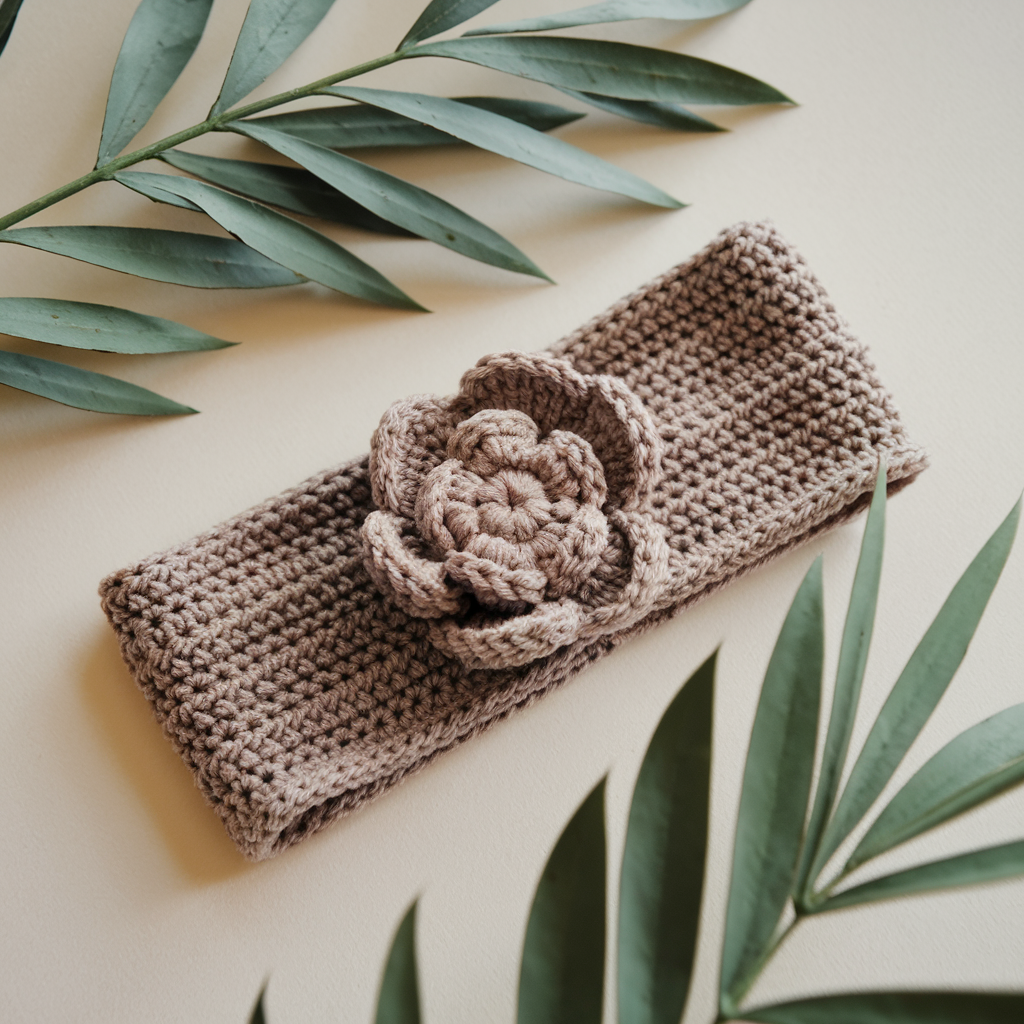
A soft headband with a removable decorative flower — elegant, feminine, and perfect for gifts.
Skill level: Beginner → Intermediate
Finished size: 20–22″ (51–56 cm) circumference; flower approx 3″ diameter
Materials: DK or worsted cotton (approx 80–100 yds), 4.0 mm hook, small button (for removable flower), tapestry needle.
Stitch glossary: MR (magic ring), sc, hdc, tr, picot (ch 3, sl st to base).
Band (ribbed texture)
- Ch 54 (adjust for circumference; multiple of 2). Row 1: sc in 2nd ch from hook and across (53 sc). Turn.
- Row 2: ch 1, sc in BLO across (53 sc). Turn.
- Repeat Row 2 until band measures ~3″ wide (approx 10–14 rows depending on yarn). Fasten off, leaving long tail to seam.
Flower (removable)
- MR, ch 2, work 10 dc into MR; pull tight and join with sl st. (10 dc)
- Ch 3, sl st into next dc around to create 10 loops; join and fasten off.
- For each loop: join yarn and make (sc, hdc, 3 dc, hdc, sc) to form petals. Repeat around for 10 petals. Fasten off and weave ends.
- Make a small felt or crocheted circle for backing and sew button onto it; attach small loop of yarn on back of flower that will slip over button so the flower becomes removable.
Assembly
- Seam band edges with mattress stitch to create headband loop.
- Attach the button on the front center of the band (secure with strong stitches). Slip the flower’s back loop over the button; removable flower makes washing easier.
Variations & tips
- Create layered flowers by making a smaller 6-petal motif and stacking, sewing through centers for a fuller bloom.
- Use a snap instead of a button for totally flat look.
- To make toddler sizes, reduce starting chain by 6–8 stitches and test circumference.
3. Crochet Cinched Ear Warmer Pattern

A classic cinched center ear warmer (turban-style) that gathers in the middle for a flattering fit.
Skill level: Beginner
Finished size: 21–22″ (54–56 cm) circumference; 3.25″–4″ wide
Materials: Worsted weight yarn (100–120 yds), 5.0 mm hook, small scrap for cinch or matching yarn to braid, tapestry needle.
Stitch glossary: hdc, dc, sc, BLO.
Band (worked flat then cinched)
- Ch 48 (or measure to desired circumference with gauge). Row 1: hdc in 3rd ch from hook and across. Turn.
- Row 2: ch 2, hdc in BLO across to create ribbed horizontal texture. Turn.
- Continue until band measures ~8.5″–9″ in length (this will fold and cinch to make the turban look); fasten off.
Cinch detail (center gather)
- Fold band in half widthwise so center lines up; using a long tail or contrasting yarn, make multiple whipstitches across the center back to gather the band — about 6–8 passes to create a tight cinch. Tie securely and weave in ends.
- Alternatively, crochet a narrow strip (ch 6, sc across for 2–3 rows) about 6–8″ long, wrap around the cinched center and stitch the ends together on the inside, producing a clean tube that hides cinch stitches.
Assembly & finishing
- Join short ends together with mattress stitch to form loop.
- Use the narrow wrap piece to cover the cinch for a polished look. You can slip-stitch the wrap closed or sew invisibly on the inside so front appears seam-free.
Variations & tips
- A simple variation uses a braided fabric strap from scrap yarn to wrap around center instead of crocheting a band.
- For more height, make band wider before cinching.
- This style is great in bulky yarn for quick makes.
4. Crochet Dream Weaver Ear Warmer Pattern

An airy, textured headband using shell and chain-lace stitches for boho vibes — light but warm when lined.
Skill level: Intermediate (lace control & shaping)
Finished size: 20–22″ circumference; ~3″ wide (after blocking)
Materials: Sport or DK yarn (150–180 yds), 4.0 mm hook, optional fleece lining.
Stitch glossary: shell = (5 dc in one st), ch-sp = chain space, sl st.
Pattern (worked flat with slight taper)
- Ch 60 (or width to fit circumference; choose multiple of 6 + 2). Row 1: sc in 2nd ch from hook and across. Turn.
- Row 2 (foundation lace): ch 3 (counts as dc), skip 2 sts, (5 dc) in next st (shell), skip 2 sts, dc in next st repeat across, end dc in last st. Turn.
- Row 3: ch 1, sc in each dc and sc across, placing sc into center of shells to anchor them. Turn.
- Row 4: Repeat Row 2 but offset shells so they appear staggered (place shells between previous shells for woven look). Continue Rows 2–3 for 10–12 rows until desired width.
- To avoid too much stretch in the lace, add one final row of sc in BLO to firm top and bottom edges.
Assembly
- Fold and seam the short edges; if the seam will be visible at front, add a decorative loop closure or attach a small crocheted flower to hide it.
- Because the lace is open, add a felt or fleece lining cut smaller than the band and stitch into the inside to make it warm and less drafty.
Variations & tips
- Use a variegated DK for soft color transitions.
- For a denser version, substitute shells with smaller clusters (3 dc) to reduce holes.
5. Crochet Adjustable Everglade Ear Warmer Pattern
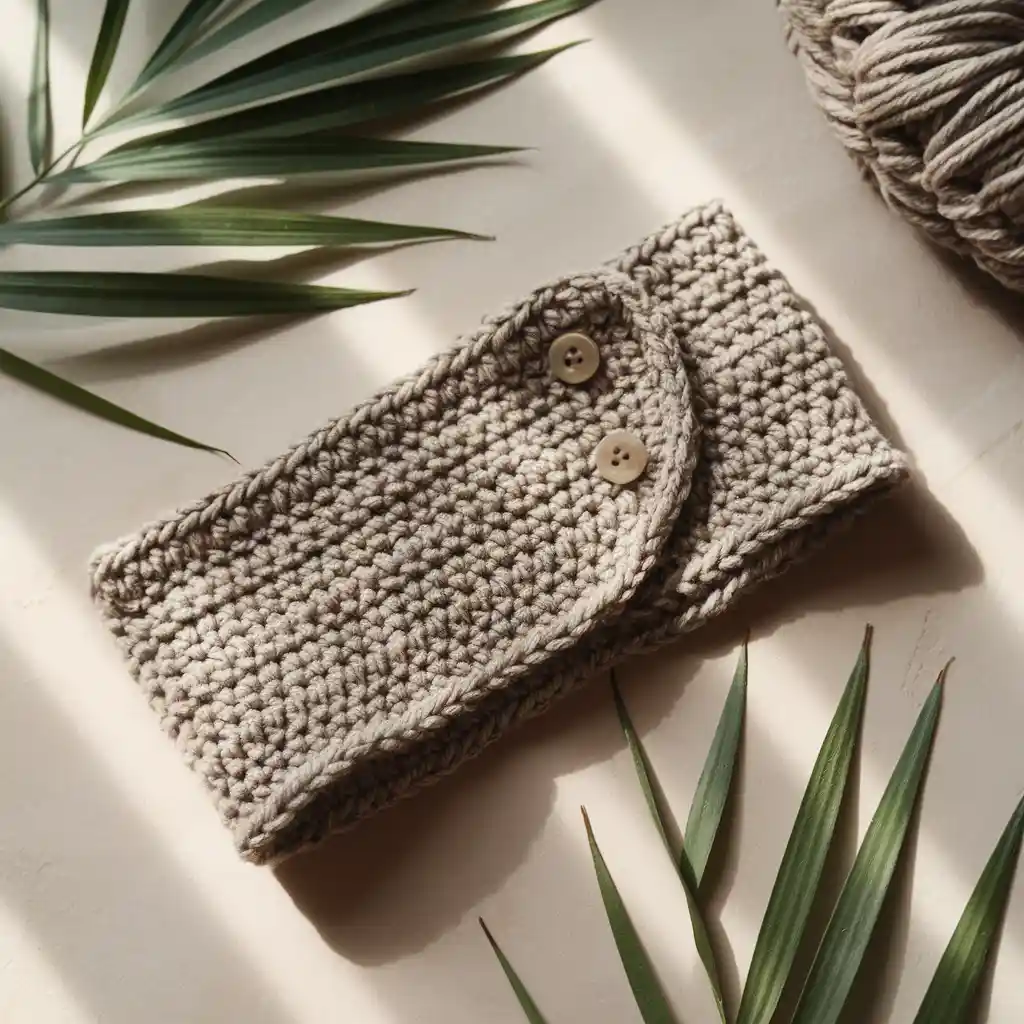
Adjustable ear warmer with buttoned strap — perfect for fluctuating head sizes or shared gifts.
Skill level: Beginner
Finished size: Adjustable 19–24″ (48–61 cm) via multiple buttonholes; 2.5–3″ width
Materials: Worsted or aran yarn (120–140 yds), 5.0 mm hook, 3 small buttons spaced for adjustment, tapestry needle.
Stitch glossary: sc, hdc, buttonhole (ch loop).
Band
- Ch 52. Row 1: sc in 2nd ch from hook and across. Turn.
- Row 2: ch 2, hdc across. Turn.
- Continue Row 2 until band measures ~3.5″ wide. Fasten off.
Buttoned strap & holes
- Decide one short end will hold buttons; on the opposite end you’ll create 3 button loops spaced 1/2–1″ apart. Create loops: attach yarn to edge, ch 6, sl st to base three times, evenly spaced; fasten off and weave ends.
- At the button end, sew 3 buttons aligned to match loops when band is folded. Use strong upholstery thread for durability.
Assembly & finishing
- Fold band with RS out and mattress-stitch seam to close. Buttons on outside can be decorative or on inside for a hidden fastening (choose based on look).
- Test fit and ensure button placement allows comfortable adjustability.
Variations & tips
- Add elastic in the seam for a mix of adjustable and stretch.
- Use contrasting yarn for the loops to make a feature.
6. Crochet Plaid Ear Warmer Pattern

Classic plaid in crochet — color-blocking stripes joined to read like tartan.
Skill level: Intermediate (colorwork & consistent tension)
Finished size: approx 20–22″ circumference, 3–4″ wide (depending on yarn)
Materials: 3 contrasting colors worsted yarn (A, B, C), 4.5 mm hook, tapestry needle, lining optional.
Technique: horizontal striping with surface crochet or tapestry technique for neat plaid intersections.
Strategy & steps
- Panel method is easiest: make a wide rectangle for front panel using alternating color blocks in rows—work say 6 rows color A, 6 rows color B, 6 rows color C—repeat to create vertical banding. Then turn the panel 90 degrees and surface-crochet narrow lines across in contrasting colors to create the plaid overlay (or make a second panel with perpendicular bands and sew them together like woven fabric).
- Example: Ch 56. Work 6 rows sc in Color A. Change to Color B and work 6 rows sc. Change to Color C: 6 rows sc. Repeat sequence once or twice until you reach desired width. Fasten off.
- For surface crochet: join Color D and use sl st or sc on RS across rows to make thin lines forming the plaid look—use a tapestry needle to plan placements then surface st across.
Assembly
- Fold and seam edges and optionally attach lining. Plaid is heavier — you can skip lining for warmth, but line for neatness.
Finishing
- Block flat to set pattern.
- Use a single edge round of sc in contrast color to tidy perimeter.
Variations & tips
- For perfect symmetry, plan grid on graph paper first.
- For speed, use a yarn with subtle tweed for a rustic plaid effect without many color changes.
7. Crochet Honeycomb Tunisian Ear Warmer Pattern
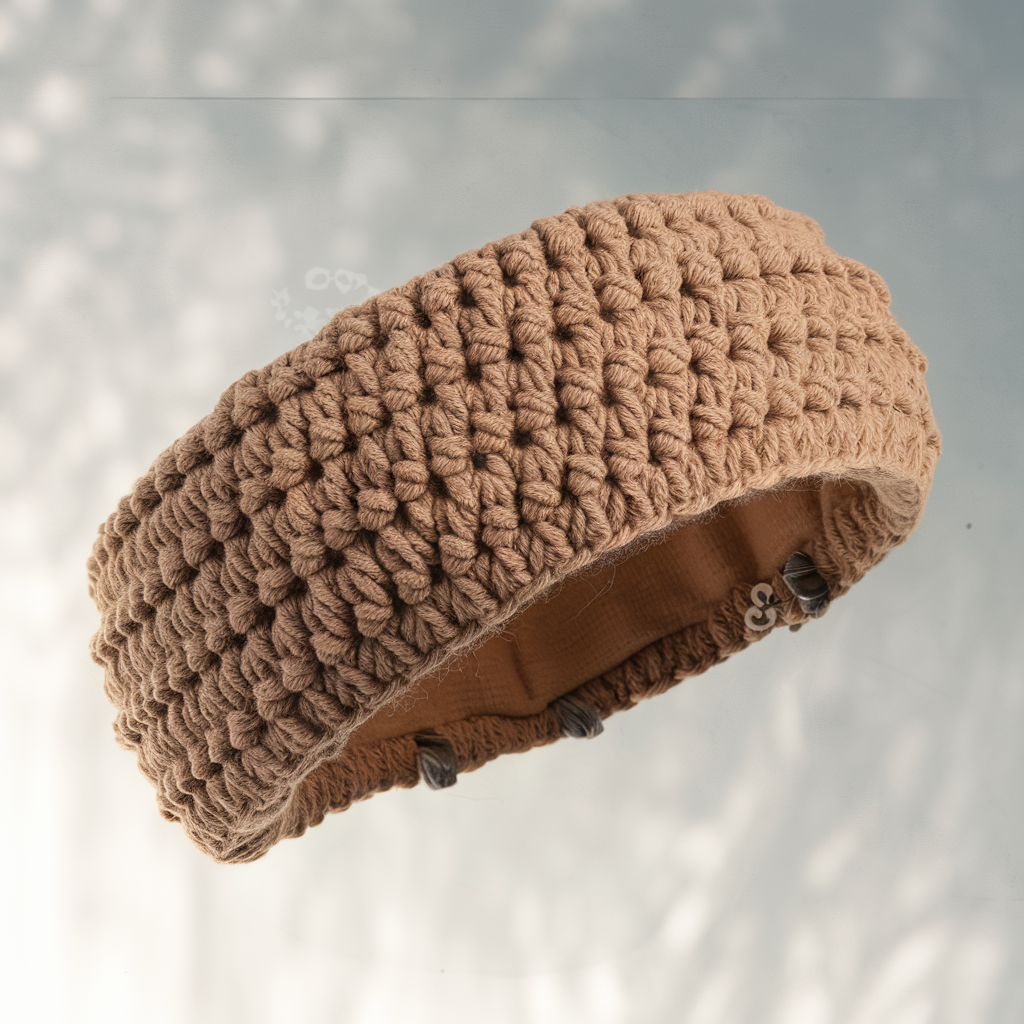
A beautiful, dense Tunisian honeycomb texture — cozy, dense, and wonderfully stretchy.
Skill level: Intermediate → Advanced (Tunisian crochet)
Finished size: 20–21.5″ circumference; 3.5″ wide
Materials: Worsted weight yarn (approx 100–140 yds), Tunisian crochet hook (6.0–7.0 mm) or cable hook, tapestry needle. Optional lining.
Stitch glossary: TSS = Tunisian simple stitch (forward pass picks up vertical bars), T-cable/honeycomb instructions use alternating TSS and T-knit; pattern uses Tunisian honeycomb stitch.
Tunisian honeycomb stitch refresher (basic concept)
- Forward pass: pick up TSS across (insert hook under vertical bars and pull up loop) leaving all loops on hook.
- Return pass: work return pass bringing yarn over and pull through two loops across as usual. The honeycomb effect requires special crossed TSS or Tunisian cable crosses — follow pattern counts.
Pattern (worked flat in Tunisian)
- Foundation chain: ch 40 (or width needed). Forward pass: pick up 40 TSS (insert hook in second ch from hook, pull up loops across). Return pass: yarn over, pull through 1 loop (selvedge), yarn over, pull through 2 loops across until one loop remains. This completes Row 1.
- Row 2–4: work standard TSS forward pass (pick up loops in vertical bars), return pass as usual.
- Honeycomb pattern: You will alternate blocks: Row A working T-knit in groups and Row B working T-purl/cross to create hex-like honeycomb. A commonly used honeycomb Tunisian chart uses multiples of 6 with specific crossed stitches — use a 6-stitch repeat: pick up loops for 6 sts, then on return perform crossing by working through the front of the third loop to create the faux cable that forms the honeycomb cell. (If unfamiliar, follow a standard Tunisian honeycomb chart — this pattern requires visual charting; try 6–8 repeats across).
- Repeat honeycomb motif rows until piece measures ~3.5″ width. Fasten off by returning pass and then working a bind-off (pull through loops two at a time).
Finishing
- Seam short ends with mattress stitch. Tunisian edges can be a little stiff — block gently by steam.
- Add lining for extra coziness and to avoid friction on hair.
Variations & tips
- If Tunisian is new, practice TSS to get comfortable with forward and return passes; honeycomb is a small step up but rewarding.
- For an easier alternative, try a simple Tunisian textured stitch like Tunisian rib if honeycomb is too fiddly.
Final Finishing Notes & Care
- Sizing adjustments: make a small gauge swatch (2×2 inches) and measure stitches per inch. Multiply desired circumference by stitch count per inch to calculate chain length for flat bands. Add seam allowance (1–2 sts) for joining.
- Lining: cut fleece or felt slightly smaller than interior to prevent puckering; hand-stitch into seam or tack in place. Lining significantly increases warmth.
- Care: most worsted/cotton acrylic blends: hand wash or machine wash gentle, lay flat to dry. Avoid tumble drying for structured pieces. Fleece lining: cold gentle wash.
- Gift-ready: attach small hang tag with yarn and care details. For toddlers/kids, replace buttons with embroidered loops for safety.
Conclusion
Ear warmers are one of those projects that reward instantly: quick to make, lovely to wear, and a perfect canvas for exploring texture, colorwork and little finishing tricks. These seven patterns — Harvest Twist, Flower, Cinched Turban, Dream Weaver lace, Adjustable Everglade, Plaid, and Honeycomb Tunisian — give you options for every mood and skill level. Pick one for your next afternoon make: keep it simple in worsted yarn for a fast gift, or choose Tunisian honeycomb for a portable challenge.


